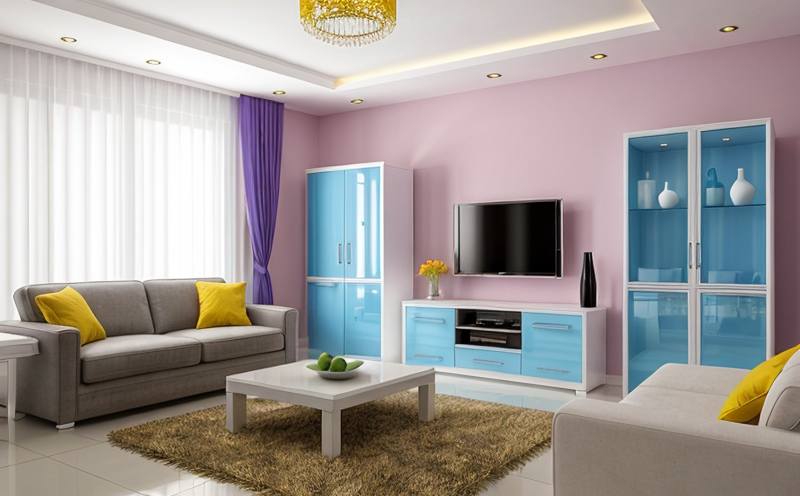UNE EN 717 Formaldehyde Emission Testing of Decorative Plastic Laminates
The UNE EN 717 standard is a cornerstone in the assessment of formaldehyde emissions from decorative plastic laminates. This test is critical for ensuring compliance with health and safety regulations, especially in environments where materials are exposed to prolonged human contact, such as home furnishings, interior design products, and other household items.
Formaldehyde is known to be a volatile organic compound (VOC) that can pose significant health risks if present at high levels. Chronic exposure has been linked to various adverse effects, including respiratory issues, eye irritation, and even more severe conditions like cancer. Regulatory bodies around the world have implemented stringent standards to control formaldehyde emissions from materials used in these applications.
UNE EN 717 provides a standardized procedure for measuring formaldehyde emission rates from decorative plastic laminates under controlled laboratory conditions. The test is designed to simulate real-world scenarios where materials might be exposed to air, ensuring that the results are relevant and reliable.
The testing process involves placing a specimen of the laminate in a climate-controlled chamber with controlled humidity levels. A known volume of air passes through this chamber for a specified period, allowing any formaldehyde gas released by the material to be captured and measured. The amount of formaldehyde present in the air is then quantified using analytical instruments.
The results from UNE EN 717 testing are expressed as milligrams per cubic meter (mg/m³) or parts per million (ppm). Compliance with this standard ensures that products meet specific emission limits, thereby protecting consumer health and safety. This testing method is widely used in various sectors including furniture manufacturing, interior design, and the production of home decoration items.
For R&D engineers involved in developing new decorative plastic laminates or improving existing ones, UNE EN 717 offers a valuable tool for optimizing formulations to meet regulatory requirements while enhancing product performance. Quality managers responsible for ensuring compliance can rely on this test to verify that their products are safe for use.
Compliance officers looking to maintain and improve the reputation of their company by adhering to international standards will find UNE EN 717 indispensable in their efforts. It provides a clear pathway to demonstrating adherence to environmental protection laws, which is increasingly important in today’s marketplaces.
Scope and Methodology
| Aspect | Description |
|---|---|
| Test Specimen | The test specimen should be a representative piece of the decorative plastic laminate, typically measuring 10 x 10 cm² and at least 3 mm thick. It must be free from defects that could affect the testing results. |
| Chamber Conditions | The chamber is maintained at a temperature between 23°C ± 2°C and relative humidity between 45% to 55%. This controlled environment simulates typical indoor conditions where the material would be used. |
| Sample Preparation | After placing the specimen in the chamber, it is exposed to a steady flow of air for a minimum of 24 hours. The sample should remain undisturbed during this period to ensure accurate measurement of formaldehyde emissions. |
| Data Collection | The concentration of formaldehyde in the air is measured using gas chromatography, ensuring precise and reliable results that can be compared against the emission limit specified by UNE EN 717. |
This standardized approach ensures consistent and accurate measurement of formaldehyde emissions from decorative plastic laminates. The use of controlled conditions and advanced analytical techniques guarantees that the test results are both credible and actionable for product developers and quality assurance teams.
Why Choose This Test
The UNE EN 717 standard is essential for manufacturers, distributors, and end-users who are committed to delivering safe products. By choosing this test, businesses can:
- Ensure compliance with international standards that protect human health.
- Avoid potential legal and financial penalties associated with non-compliance.
- Increase market competitiveness by demonstrating a commitment to quality and safety.
- Promote brand reputation through consistent adherence to regulatory requirements.
- Meet the expectations of environmentally conscious consumers who demand safer products.
This testing ensures that decorative plastic laminates meet stringent formaldehyde emission limits, making them suitable for use in residential environments. It also provides valuable insights into material behavior under controlled conditions, enabling manufacturers to refine their products and enhance overall product quality.
Competitive Advantage and Market Impact
- Innovation Leadership: By staying ahead of regulatory changes through rigorous testing, companies can innovate with confidence. UNE EN 717 helps identify potential issues early in the development process.
- Increased Customer Trust: Meeting or exceeding formaldehyde emission limits builds trust and enhances brand loyalty among consumers who are increasingly concerned about indoor air quality.
- Better Marketing Opportunities: Companies that pass UNE EN 717 testing can leverage this information in their marketing strategies, differentiating themselves from competitors who may not adhere to such stringent standards.
- Enhanced Product Integrity: Consistent adherence to international standards ensures product integrity and reliability, which is crucial for maintaining long-term business relationships with suppliers and customers.
In summary, compliance with UNE EN 717 formaldehyde emission testing positions companies at the forefront of health and safety standards, enhancing their reputation in a competitive market. This commitment to excellence not only protects consumer well-being but also contributes positively to the environment by reducing harmful emissions.





